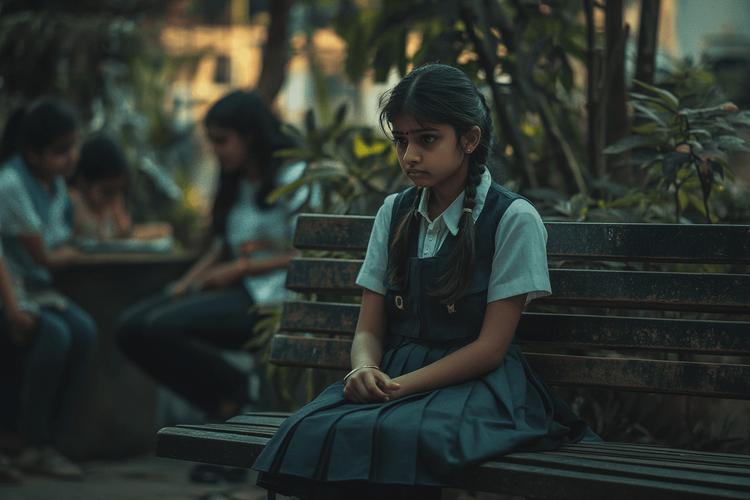Bullying in Schools: Causes, Effects & Solutions

Table of Contents
- Why Bullying Happens: Root Causes
- The Psychological and Emotional Effects of Bullying
- When Teachers Become Bullies
- Steps to Take: How to Respond to Bullying
- Preventing Bullying: Long-Term Strategies
- Steps to Take: How to Respond to Bullying
- Preventing Bullying: Long-Term Strategies
- PlanetSpark’s Role in Building Empathetic, Confident Communi
- Conclusion
- FAQs: Bullying and Creative Writing
Bullying is a serious and growing concern in schools globally. It is characterized by the intentional infliction of harm, discomfort, or humiliation on another person. This harmful behavior may include teasing, physical aggression, verbal threats, social exclusion, or cyberbullying. At its core, bullying reflects a power imbalance where the aggressor uses their perceived or actual influence, such as physical dominance, social popularity, or access to sensitive information, to harm others. Victims are often targeted for being different, whether in terms of appearance, gender identity, cultural background, language, or ability.
Because bullying often stems from complex psychological or environmental factors, some argue that bullies deserve empathy or second chances. While it's important to address the root causes of bullying, the well-being and safety of the victims must always come first. Creating a supportive, inclusive school culture is essential to mitigating bullying. This is where educational programs like PlanetSpark's Creative Writing Course play a powerful role. Designed to help children express themselves with clarity and confidence, the course strengthens emotional intelligence, storytelling, empathy, and communication skills that not only enrich academic performance but also foster understanding and kindness in peer interactions.
Why Bullying Happens: Root Causes
Understanding the causes of bullying is essential to addressing the issue effectively. Here are some of the most common factors:
1. Insecurity and Low Self-Esteem
Many bullies act out to cover up their insecurities. By dominating someone else, they temporarily feel empowered.
2. Family Environment
A child growing up in a violent or neglectful home is more likely to display aggressive behaviors at school.
3. Peer Pressure
Students sometimes engage in bullying to gain acceptance or approval from their peers.
4. Media Influence
Exposure to violent or aggressive behavior in TV shows, movies, or games can normalize such behavior.
5. Lack of Supervision
Bullying often occurs in unsupervised areas such as bathrooms, playgrounds, or hallways.
6. Cultural and Social Norms
In some communities, assertiveness or dominance is praised, making bullying seem like a form of strength rather than an issue.
7. Cyberbullying and Digital Anonymity
With the rise of social media and messaging apps, bullies now use anonymity online to spread hate, rumors, or harassment without immediate consequences.
The Psychological and Emotional Effects of Bullying
The impact of bullying on a child can be devastating and long-lasting. Victims often suffer from:
1. Low Self-Esteem and Self-Worth
Being treated as inferior makes victims doubt their abilities and worth.
2. Depression and Anxiety
Persistent bullying can lead to clinical depression, generalized anxiety disorder, and even PTSD.
3. Isolation and Loneliness
Victims often withdraw from social interactions to avoid further bullying.
4. Academic Decline
Fear of attending school or difficulty concentrating can negatively affect academic performance.
5. Suicidal Thoughts and Self-Harm
In extreme cases, bullying has been linked to suicidal ideation or attempts, especially among adolescents.
6. Long-Term Behavioral Changes
Some victims develop defensive habits like aggression or mistrust toward others, even in adulthood.
7. Substance Abuse
Research shows a higher risk of substance abuse in teenagers who experience repeated bullying.
When Teachers Become Bullies
While peer bullying is more frequently discussed, teacher bullying is equally damaging and often overlooked. Teachers can bully students through:
- Verbal abuse or sarcastic remarks
- Public humiliation
- Unfair grading or punishment
- Favoritism and exclusion
The power imbalance between teacher and student makes it difficult for children to report such behavior. Teacher bullying can lead to fear of learning, academic disengagement, and emotional trauma.
Steps to Take: How to Respond to Bullying
1. Encouraging Open Communication
Children should feel safe talking to parents, teachers, or counselors about bullying.
2. Adult Intervention
Attempting to resolve bullying without adult support is usually ineffective. Trusted adults must step in.
3. School Policies and Enforcement
Schools must adopt clear anti-bullying policies and enforce them strictly.
4. Counseling and Mental Health Support
Victims and even bullies need access to counseling to address underlying emotional issues.
5. Restricting Harmful Media
Limiting exposure to violent or aggressive content on television or the internet can reduce behavioral imitation.
6. Empowering Victims
Workshops, therapy, and role-playing scenarios can help victims rebuild self-confidence and assertiveness.
7. Legal and Institutional Support
Many countries now have anti-bullying legislation in place. Parents can consult school boards or legal advisors if the school fails to take action.
Preventing Bullying: Long-Term Strategies
1. Classroom Discussions and Awareness Campaigns
Schools should regularly dedicate time to discuss the consequences of bullying and promote empathy.
2. Promoting a Positive School Culture
Encouraging inclusivity, kindness, and cooperation among students creates a healthy learning environment.
3. Training for Teachers and Staff
Teachers should be trained to recognize signs of bullying and to intervene appropriately.
4. Involving Parents
Parents should be educated about the signs of bullying and involved in crafting intervention plans.
5. Empowering Bystanders
Teaching students to stand up for others and report bullying can turn bystanders into allies.
PlanetSpark encourages this kind of active participation and leadership through group storytelling clubs and public speaking practice. Join now for a free class or trial session.
6. Creating Safe Online Spaces
Cyberbullying prevention programs should be part of the curriculum, teaching digital responsibility and etiquette.
7. Inclusive School Activities
Diverse group projects, inclusive sports, and multicultural festivals can promote unity and reduce feelings of isolation among students.
8. Implementing Restorative Justice Models
Rather than focusing only on punishment, schools can use conflict resolution circles and restorative dialogue to heal harm and reintegrate both parties into a positive learning environment.
9. Student-Led Initiatives and Peer Mentoring
Schools can empower students by allowing them to lead awareness campaigns, mediate conflicts, and provide support to peers through structured mentoring programs. These initiatives build leadership skills and foster a culture of compassion and accountability.
10. Continuous Monitoring and Feedback Loops
Bullying prevention is not a one-time event but an ongoing effort. Schools should implement systems to regularly collect student feedback, track incidents, and adapt policies based on real-time data.
11. Leveraging Technology for Bullying Reports
Anonymous reporting tools and AI-powered monitoring platforms can help schools detect bullying patterns early. Digital tools empower students to speak up safely and help authorities take preventive action.
12. Emphasising Character Education
Incorporating values like empathy, honesty, and resilience into the curriculum reinforces moral development. Educators can use storytelling, historical narratives, and ethical discussions to teach students how to make kind and courageous choices.
13. Recognising Positive Behaviour
Schools should highlight and reward acts of kindness, inclusion, and cooperation. Acknowledging positive behavior encourages students to model respectful and supportive conduct.
14. Involving Community Stakeholders
Anti-bullying efforts should extend beyond schools. Local leaders, mental health experts, law enforcement, and NGOs can collaborate with schools to create holistic safety nets for children.
15. Building Emotional Literacy
Helping children understand and articulate their emotions builds self-regulation and empathy. Lessons in emotional vocabulary, perspective-taking, and reflective listening can be built into everyday learning routines.
Programs that improve communication and confidence, like PlanetSpark’s Creative Writing Course, can empower children to raise their voices against unfair treatment.
Steps to Take: How to Respond to Bullying
1. Encouraging Open Communication
Children should feel safe talking to parents, teachers, or counselors about bullying.
2. Adult Intervention
Attempting to resolve bullying without adult support is usually ineffective. Trusted adults must step in.
3. School Policies and Enforcement
Schools must adopt clear anti-bullying policies and enforce them strictly.
4. Counseling and Mental Health Support
Victims and even bullies need access to counseling to address underlying emotional issues.
5. Restricting Harmful Media
Limiting exposure to violent or aggressive content on television or the internet can reduce behavioral imitation.
Preventing Bullying: Long-Term Strategies
1. Classroom Discussions and Awareness Campaigns
Schools should regularly dedicate time to discuss the consequences of bullying and promote empathy.
2. Promoting a Positive School Culture
Encouraging inclusivity, kindness, and cooperation among students creates a healthy learning environment.
3. Training for Teachers and Staff
Teachers should be trained to recognize signs of bullying and to intervene appropriately.
4. Involving Parents
Parents should be educated about the signs of bullying and involved in crafting intervention plans.
5. Empowering Bystanders
Teaching students to stand up for others and report bullying can turn bystanders into allies.
PlanetSpark’s Role in Building Empathetic, Confident Communicators
PlanetSpark, a leading online platform for English communication and public speaking, recognizes the role of education in reducing bullying and empowering children. Our Creative Writing Course is designed to help students express themselves better, develop empathy, and build emotional resilience.
Why Choose PlanetSpark’s Creative Writing Course?
1. 1:1 Personal Trainers for Every Child
Every PlanetSpark student is matched with a certified communication expert for personalised, one-on-one live classes. Trainers:
- Understand each child’s unique learning style
- Provide real-time feedback
- Strengthen storytelling, grammar, fluency, and creative expression
2. Personalised Curriculum
After an initial assessment, each student receives a customised learning roadmap that:
- Identifies gaps in grammar, vocabulary, and structure
- Progresses from simple writing to advanced public speaking
- Adapts continuously based on progress
3. SparkX: AI-Enabled Video Analysis Tool
Children upload video presentations and receive AI-generated performance reports that cover:
- Voice modulation and clarity
- Body language and presence
- Grammar and flow of content
4. AI-Led Practice Sessions
Students practise speeches and storytelling with a virtual AI coach that:
- Simulates real-time speaking tasks
- Provides instant feedback
- Reinforces learning outside class hours
5. Spark Diary: Digital Writing Journal
Children use Spark Diary to:
- Write reflections, stories, and poems
- Practice with creative prompts
- Build consistency and confidence
6. Gamified Learning Modules
Engaging activities like:
- Vocabulary quizzes
- Spelling challenges
- Grammar games
Keep children excited about daily practice and learning.
7. Structured Parent-Teacher Meetings
Regular PTMs keep parents informed about:
- Performance trends
- Improvement areas
- Next steps for learning
8. Comprehensive Progress Reports
Reports include:
- Content quality
- Creativity and critical thinking
- Confidence and voice modulation
- Grammar and sentence structure
9. Clubs and Communities
Exclusive clubs help students collaborate and grow:
- Debate Club
- Story Writing Club
- Comedy and Podcast Circles
- Writers Guild
10. Sparkline: Safe Sharing Platform for Kids
Students can:
- Share their writing and performances
- Receive peer feedback in a moderated environment
- Build digital confidence
11. Showcases and Contests
PlanetSpark hosts regular events like:
- Storytelling and speech competitions
- Open mic sessions
- Poetry and comedy showcases
12. SparkBee and SparkShop
- SparkBee offers fun grammar and vocabulary quizzes
- SparkShop gives access to affordable, skill-based eBooks
Conclusion
Bullying is a serious issue that needs immediate attention from educators, parents, and students alike. Its impact is long-lasting and detrimental to the mental, emotional, and academic well-being of a child. Schools must actively work to build inclusive environments through discussions, counseling, and firm policies.
PlanetSpark adds to the solution by nurturing confident, expressive, and empathetic communicators who are better equipped to resist bullying, stand up for themselves, and express their concerns constructively. Whether through creative writing, storytelling, or public speaking, children learn to value themselves and others, laying the foundation for a bully-free future.
FAQs: Bullying and Creative Writing
Q1. What is bullying, and how does it affect a child?
Bullying involves repeated harmful actions such as teasing, threatening, hitting, or stealing. It can lead to serious mental health issues like depression, anxiety, low self-esteem, and even suicidal thoughts.
Q2. Why do children become bullies?
Common reasons include insecurity, peer pressure, lack of supervision, and troubled home environments. Some bullies may be mimicking behaviors they've seen at home or in the media.
Q3. How should a child report bullying?
Children should be encouraged to speak to a trusted adult, whether it be a parent, teacher, or counselor, rather than trying to resolve the issue alone.
Q4. Can teachers also be bullies?
Yes. Teacher bullying through verbal abuse, favoritism, or public humiliation can deeply affect a child’s emotional well-being and motivation to learn.
Q5. What is PlanetSpark's Creative Writing Course, and who is it for?
PlanetSpark offers live, one-on-one creative writing classes for children aged 6 to 16. The course enhances grammar, sentence structure, story development, and expressive confidence.
Q6. How does creative writing help prevent bullying?
Creative writing encourages empathy, self-reflection, and emotional articulation. Courses like those at PlanetSpark empower children to express their feelings constructively and build social understanding.
Q7. How is PlanetSpark's course personalised and monitored?
Each child follows a customised roadmap and receives ongoing feedback through AI tools, parent-teacher meetings, and trainer evaluations to ensure measurable progress in writing and communication.
Personalized Communication Report
Record a video to get a AI generated personalized communication report for your child

Hi There, want to try these
tips for your child with
LIVE with our expert coach?
Let's check your child's
English fluency
